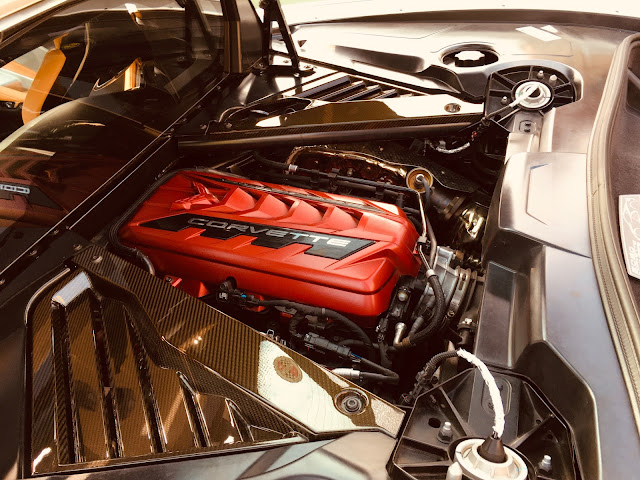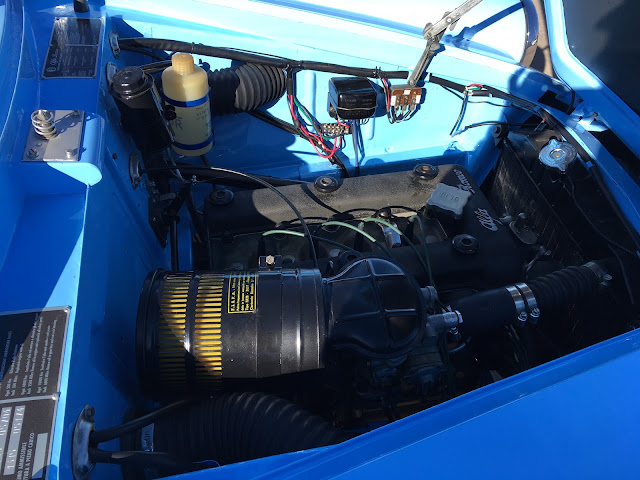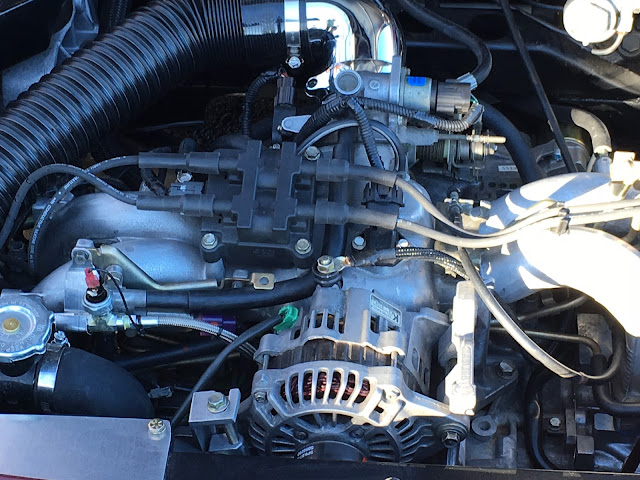Despite the presence of the Shelby American Collection*, Boulder, Colorado has always felt a lot more like a hangout for mountain bikers than for classic car geeks. Which isn't to say there aren't people here who know their way around cars. Vanatta Auto Electric, at 1981 Pearl Street in downtown Boulder, is a reminder of the Boulder that existed before the internet and designer coffee, when the downtown featured a machine shop (though it was one that did work for NASA) and even a hardware store. When I found out that the FuelFed people were having a Coffee & Classics event for old European cars in front of Vanatta, just south of Pearl Street on 8th, I decided to bring my old Jag, thinking that England was sort of European, at least until Brexit. Maybe because of Brexit, though, we got parked near that shady tree beyond the Ford van. More on the Jag in some future post...


There had to be a Ferrari, and in this case it was a modern California retractable hardtop. The California body design was created by Pininfarina, like that of its late Fifties / early Sixties namesake. Unlike those earlier ragtop spiders, though, the modern California was the first front-engined Ferrari road car to be powered by a V8. Also unlike their approach on the earlier V12-powered Californias, PF spent hundreds of hours studying air flow patterns in the wind tunnel...
The early, short wheelbase, chrome-bumper Porsche 912 had tasty "S" wheels. Next to it, though, was a swoon-worthy Alfa 2000 GTV…
If I'd had to drive home in something other than the car I'd brought, this would've been the one. A good example of a great car, and a timeless design. And one with no microchips anywhere...

The June 27 event, the second Coffee & Classics in downtown Boulder, had a high visitor to vehicle ratio. Happily, there were no concours judges in evidence anywhere, and anything with a European connection was accepted, included the Seventies VW Thing, a Karmann Ghia, an AMG Mercedes, my '67 E-Type, the immaculate GTV, and a '67 (I think) Porsche 912. We're hoping for more cars at the next Coffee & Classics, which will be on Sunday July 25, from 8 to 10 AM at 8th and Pearl in downtown Boulder. If it's like most Sunday mornings, there will be live jazz at Spruce Confections, which conveniently also offers coffee, at 767 Pearl Street. I'll bring a '67 Jaguar E-type FHC, or a 1970 Lancia 2000 PF coupe, whichever is happiest with me that morning, or both, if we can convince an extra driver to come along...
It's a good thing the Boulder event organizers chose the last Sunday morning of spring and summer months, because that way their event will never be in conflict with the other Cars and Coffee event, at the eastern end of Boulder County in Lafayette, which happens the first Saturday of designated warm months. This one has been going on for a few years, and casts a wider net, including domestic, Japanese and European makes. I showed up on a warm spring day 3 years ago. Maybe because the event organizers were shooting for a theme of "cars in outdated colors", or trying to contrast scruffy condition with textbook restorations, they had me park my '67 Jag next to this flawless Alfa Giulietta Sprint from a decade earlier...


Or maybe they were just trying to show the evolution of fastback GT coupes. Franco Scaglione's design for the Bertone-bodied Alfa Giulietta Sprint was the first example of a modern GT car at an affordable price when it appeared in 1954. We can underline the "modern" part by pointing out that the Alfa's high-revving, DOHC inline four with aluminum block and head was not something that had appeared in a mass-produced car until this moment.
Along with the eagerness of the 1.3 liter engine, which made over 90 hp in Veloce form, the Sprint's rigid, lightweight chassis design and quick steering made for alert, responsive handling.
Pre-Fiat Lancias of any description appear less frequently than Alfas at Cars & Coffee; this Fulvia coupe appeared at the same show in Lafayette and appeared to be in fine shape, displaying the crisp, glassy form of Piero Castagnero's original mid-Sixties design, though without the bumpers he'd intended...
The "2.5" insignia on the grille, however, hinted at a possible surprise under the hood. Fulvias, built from 1963 through '76, were never offered with engines larger than 1.6 liters. Because Lancia was a company run by its engineering department, the narrow-angle V4 was offered in six different displacements, and with 3 slightly different angles between cylinders, during that period. Might someone have put a Gamma flat-four from the Fiat era in there? Would that even fit?
Well, the owner-builder didn't try that, or even something like an earlier Flavia flat four, maybe because he was unaware that before the Fiat takeover, Lancia had made anything other than engines with "V" configurations. He did an impressive amount of work, however, in making a tidy installation of the 2.5 liter Subaru flat four that went into his Fulvia. One wonders if it would'nt have been a lot less work just to rebuild the original Fulvia V4. But that might have violated the hot rod spirit that seemed to be in evidence at Lafayette Cars & Coffee...
This modified original BMC (as opposed to modern BMW) Mini Cooper took a different approach to "hot rod" than the sleeper Fulvia. With its chopped top, flared fenders and green Union Jack pattern on the roof, it screamed "SoCal custom car". Because the bonnet stayed closed, we never found out what powers this little creature...
In a slightly bigger size category, but in the same hot rod spirit, we found a Ford Shogun, based on the now-forgotten Ford Festiva of the late Eighties...
Back then, an outfit called Special Editions (C. Beck and R. Titus) had the idea of mounting the Yamaha-built 4-cam, 24-valve Taurus SHO V6 in the back seat area of the Ford Festiva, transforming a humble front-drive econobox into a mid-engined, rear drive tire-shredder capable of running the quarter mile in 12.9 seconds at just under 101 mph. Only seven were built, each in a different color, with 003, the silver one, going to Jay Leno. This is apparently 005, the purple Shogun equipped with a roll cage and 5-point belts for SCCA duty...

Apparently one reason the Shogun found so few buyers was its $42,000 price tag in 1989. This was, however, about $10k less than a base Porsche 911 that year. Perhaps the Special Editions crew needed a better connection with Ford, the kind that Alpine had with Renault when they built the similarly crazy 5 Turbo rally car. Or that kind that Shelby had with Ford, back when Shelby American built this Shelby Mustang GT500, their last take on the Mustang theme, from 1969-'70. Shelby made 1,536 of the GT500 fastback in 1969, but only 286 in 1970, their final year. This example appeared across the lane from the Shogun.
The next Lafayette Cars & Coffee will be at 355 W. South Boulder Road in Lafayette, Colorado (80026) on Saturday August 7, from 7 to 10 AM.
*Footnote: For photo essays on the Shelby American Collection, see "Roadside Attraction—Shelby American Collection Part 1: AC and Cobra", posted here on 12/28/17, and "Roadside Attraction—Shelby American Part 2: Ford GT40", posted on 12/31/17. We featured "Cars and Coffee in New Canaan" on 10/28/19, and shed some light on the cultural forebears of the Cars and Coffee movement in "Lost Roadside Attraction: Before Cars & Coffee There Was Zumbach's", posted 4/11/18.
Errata:
Original text mis-identified the green Porsche as a 911; it's a 912 according to the owner, who oughta know. Should've blown up the rear view and put on those reading glasses. Apologies.
Photo Credits:
All photos are by the author.













































